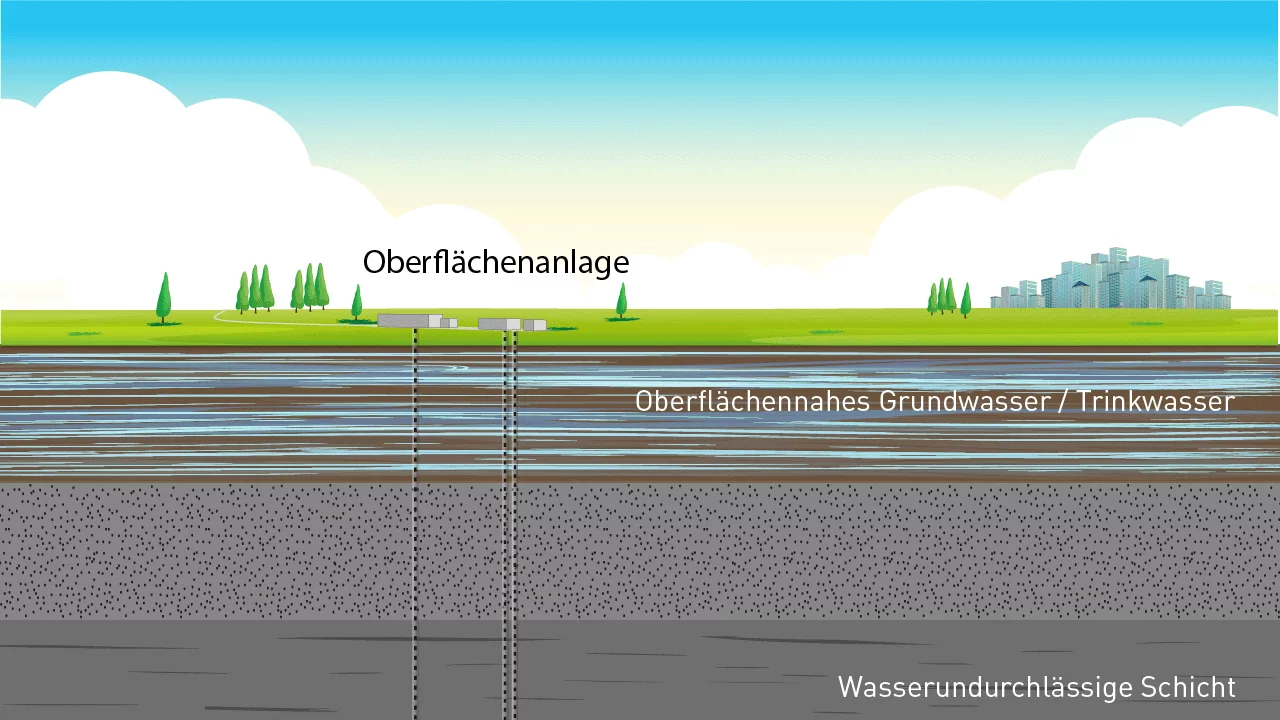
How we protect groundwater
Key points at a glance
– Nagra has been researching groundwater for decades.
– Nagra knows a lot about the different types of groundwater and how to protect it.
– A deep geological repository does not endanger our drinking water.
Groundwater plays a key role in the site selection process for a deep geological repository. We have to prevent radioactive particles from contaminating our groundwater. For this reason, the repository will be constructed in a layer of rock that is largely water-impermeable, the so-called Opalinus Clay. The protection of groundwater is a recurring topic of public discussion: last year, for example, Swiss voters were presented with initiatives on clean drinking water and pesticide.
In mid-December 2021, an urgent interpellation was submitted to the Zürich cantonal council titled “Deep geological repositories and deep groundwater – an as yet unexplored conflict of use in the underground: clarify first and decide after or vice versa?”
The public clearly has great interest in groundwater. With this article, we provide an overview of what we know about groundwater in northeastern Switzerland.
Groundwater, deep groundwater, drinking water reserves: what are we talking about exactly?
When we normally refer to groundwater, we actually mean near-surface groundwater. In Switzerland, we use this as drinking water and to irrigate our fields. This groundwater is mainly found in deposits dating back to the ice ages. These deposits usually consist of gravel and sand and are highly water-permeable. In Switzerland, we are fortunate to have a lot of near-surface groundwater that is replenished by precipitation and river water. The vast majority of our drinking water reserves thus lie in near-surface groundwater.
However, groundwater can also be found several hundred metres below the surface. This is referred to as deep groundwater. It flows mainly through cracks, so-called fissures, in solid rock. Deep groundwater differs from near-surface groundwater in that it has often remained deep below ground for a very long time. As a result, it is warmer and usually contains many dissolved minerals. So many, in fact, that most deep groundwaters are saline. It is therefore next to impossible to use deep groundwater as drinking water without extensive purification. The best-known exception in northeastern Switzerland is the former Eglisau mineral water. This was a deep groundwater in a shallow rock layer.
Our drinking water and the various deep groundwaters that exist in northeastern Switzerland are widely separated from each other by largely impermeable layers of rock.
Could the deep geological repository contaminate the groundwater?
Radioactive particles must not contaminate the groundwater under any circumstances. For this reason, the repository will be constructed in a layer of rock that is largely water-impermeable, the so-called Opalinus Clay. The Opalinus Clay even fixes itself: if fissures were to form in the Opalinus Clay and water were to enter, the rock would absorb the water, causing it to swell. As a result, the fissures would be sealed again. This allows the Opalinus Clay to prevent flowing groundwater from coming into contact with the waste over a very long time period.
Repository construction in the Opalinus Clay requires several accesses to the underground. These must be constructed through rock formations containing groundwater – this is the case in all three potential siting regions. However, such construction through groundwater is standard today and unproblematic thanks to special structural engineering techniques. Groundwater is not contaminated during the construction and operation of the temporary accesses to the repository.
Level of knowledge on deep groundwater
Nagra knows the underground environment in the three siting regions Jura Ost, Nördlich Lägern and Zürich Nordost very well. The underground also includes those rock formations containing deep groundwaters, and Nagra scientists have been studying these for many years. For the site selection process, Nagra has to have a comprehensive understanding of the groundwater. T he first investigations of the deep groundwaters began in the 1980s. Since then, the level of knowledge has continuously improved. A comprehensive report on the deep groundwaters of northeastern Switzerland was published at the end of 2014 (in German). This spring, a new report updating this database will be published.
During the course of the deep borehole investigations conducted over the past three years, the deep groundwater has also been studied in detail. Nagra’s understanding of the deep groundwater in northeastern Switzerland could essentially be confirmed: we know which layers contain deep groundwater and we know their properties and can estimate how they flow. The information from the deep boreholes has not yet been conclusively evaluated. As soon as the data have been fully analysed, this picture will become even clearer. However, even then it will not be possible to represent reality down to the last detail. We can nevertheless still obtain a good understanding of the overall groundwater system in northeastern Switzerland.
Could the deep geological repository result in restrictions on use?
Neither the drinking water at the surface nor the deep groundwater will be contaminated with radioactivity – mainly due to the tight layer of Opalinus Clay. The groundwater can therefore still be used normally and without restrictions. On a very local basis, however, use of the underground will be restricted: the tight rock formations surrounding the repository will be strictly protected over an area of a few square kilometres. These tight rock formations represent the main safety barrier of the repository and must not be drilled through or impaired by any other usage. There will be restrictions for this small area deep underground.
Conclusion
Protecting groundwater is a key aspect of our mission. Nagra has been investigating the various groundwaters in northeastern Switzerland since the 1980s. Since then, the level of knowledge has continuously improved. Deep groundwater and near-surface groundwater differ greatly. Groundwater is strictly protected. A deep geological repository does not lead to any restrictions on the use of drinking water. Usage restrictions will only apply for tight rock formations deep below the immediate vicinity of the repository.